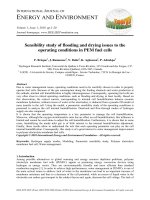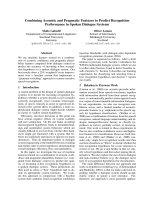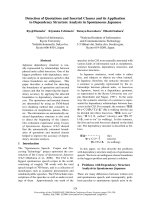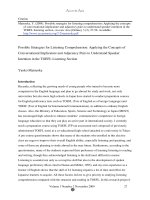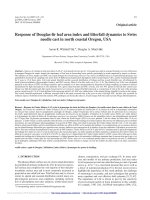Risks and consumers reluctance to adopt e commerce in vietnam
Bạn đang xem bản rút gọn của tài liệu. Xem và tải ngay bản đầy đủ của tài liệu tại đây (880.71 KB, 106 trang )
Risks and Consumer’s Reluctance to adopt
E-commerce in Vietnam
Giang Khanh Bao Hoang
Email:
Instructor Name: Prof. Le Nguyen Hau
Email:
Contents
Chapter 1. INTRODUCTION
E-commerce in Viet Nam
Management Problem
Research Problem:
Research Objectives
Research Scope:
Chapter 2. LITERATURE REVIEW AND
HYPOTHESIS DEVELOPMENT
Technology Acceptance Model (TAM)
Perceived Risks
Perceived Risk with Products and Services
(PRP)
Perceived Risk in The Context of Online
Transaction (PRT)
Research Hypotheses
Perceived Risk in the Context of Online
Transaction
Perceived Risk with Products/ Services
E-commerce Adoption Model
Chapter 3. RESEARCH METHODOLOGY
Research process
Research Method
Measurement scale
Perceived Risk with online transaction
Data collection Method
Data Analysis Method
Chapter 4. DATA ANALYSIS
Descriptive statistics of sample
Final sample
Demographic Statistics
Measurement scale
Exploratory Factor Analysis
Hypotheses
research model
Regression Analysis
Testing
Regressions
Chapter 5. CONCLUSION AND
RECOMMENDATION
Discussion
Recommendations
Limitations
References
Risks and Consumer’s Reluctance to adoptE-commerce in Vietnam
Chapter 1.
INTRODUCTION 1.1 E-commerce in Viet Nam
Vietnamese people are used to purchasing products in a traditional way, which means
that they will go to show rooms or company representatives to get products and services.
This brick and mortar method provides great benefits to businesses. An actual physical
location gives customers a sense of security and a face to the brand. Customers can also
receive their purchased products or services immediately. This traditional shopping
experience, however, creates higher expenditures on businesses since they need to spend
money on shopping locations, staff and facilities.
The Internet has grown dramatically in recent years due to the development of
information technology. From our daily lives to commercial transactions between businesses,
the Internet has profoundly impacted and changed the way we do businesses. The number of
people who go online is bolstering. In 2011 Vietnam’s E-commerce Penetration level was
only 0.25% at the value of 154 million USD. However, the projected level will triple to
0.71% with online retails reaching 900 million USD by the end of 2016 (T.D., 2014). Ecommerce presents enormous opportunities for both consumers and businesses from all over
the world, especially in Vietnam. With a population of 90 millions, Vietnam market is an
attractive place for businesses no matter what size. Giant business benefit from
implementing E-commerce. Top local businesses are the main contributors in the rapid
increase of E-commerce Penetration. These local e-businesses include Nguyen Kim,
thegioididong.com, and FPTShop which project their online sales volume to reach 10, 50
and 25 million USD respectively by 2014 (T.D., 2014). For start-up brands, or businesses
that lack financial resources to open various store locations, the traditional method of selling
products and services becomes a challenge. By implementing E-commerce into their
business model, nonetheless, these companies can reach out far and wide to consumers.
In contrast to traditional shopping experience, online transactions encompasses
distinctive features such as extensive use of technology for transactions, the distant and
impersonal nature of the online market environment, and the implicit uncertainty of using
open network infrastructures for transactions (Naiyi, 2004). Web retailer opportunistic
1
behaviormay arise when there exists spatial and temporal separation between consumers and
marketers. Thus lead to increasing consumers’ fear of fraud from product and identity
uncertainty (Naiyi, 2004).Moreover, third party or hackers may post risks related to
consumer’s personal and financial information.
Reports from breach of Internet security comes up on the news more often than not.
The issue becomes more critical when the reports are about loss of customer information
from big companies. Mitchell and Jarupunphol state “the fact that breaches of Internet
security are reported with great frequency means that there is a danger that potential users
will be reluctant to engage in E-commerce because of fears about security” (2001).
Preferably, perceived risks in E-commerce transactions should be the same or similar to that
of a traditional transaction (Jarupunphol & Mitchell, 2001).
Participants, seller and buyer, in a traditional transaction can face to face thus there
exists little distrust between people. But this is not the case for E-commerce.The location of
the business and goods are relatively unknown. Personal contact is limited between seller
and buyer. Even when the buyer inquires a questionon the product, there is no guarantee that
the seller is providing the correct details and it is likely for a time delay in response.
Furthermore, legal framework varies from different business sites and is not very clean-cut
in E-commerce. Therefore, mutual trust is an important issue.
Another issue that becomes prominent in E-commerce is network attack, which can
be associated with any online transaction risk. Such risk encompasses: IP spoofing attacks,
meaning a hacker steals an authorized Internet Protocol (IP) address and proceeds to use that
IP to inquire businesses, information theft such as stealing business or some important
personal information (message, such as e-mail messages, credit card numbers). Another
common attack is hacking user’s password to e-mail, bank account, etc. Social engineering
attacks targets Internet users who have little understanding their computer system. A typical
example of this attack is when the hacker sends an e-mail message to the users and asks for
their password (Yanyan, 2014).
Entrepreneurs in Vietnam have been trying to develop their business through Ecommerce. They have created websites and stay connected through emails to clients to
2
advertise their products. They have even joined e-trading floors to reach out to potential
clients. Yet not all consumers are willing to experience shopping online. Several valid factors
contribute to such reluctance in adopting E-commerce. According to Naiyi (2004) “Web
shopping involves a number of concerns of consumers, including trade fraud, product
quality, monetary losses, privacy, information quality and so on”.Those concerns may be the
consequences of a failed purchase online or from the perceived risks that involve in the lack
of personal or physical presence of the opposite end.
Risks are obstacles that prevent consumers from willing to participate in online
transactions. Therefore, any obstacle to E-commerce such as perceived or real risks in
financial transaction, product performance, delivery, time etc. need to be examine and
resolve. With examination and resolution, E-commerce can evolve to a safer market for
consumers.
3
1.2
Management Problem:
What types of risks should firm be aware of and reduce from in order to attract more
consumers into adopting E-commerce in Vietnam?
According to the CEO of Vatgia.com, one of the major online E-commerce sites in
Vietnam, “The Vietnamese market has never experienced the hyper-supermarket stage
before. Therefore, the local purchasing mind-set hasn’t followed the current trend, online
shopping. Moreover, the space and time restraints prevent E-commerce from getting its
deserved position. Delay in money delivery makes consumers and suppliers gradually lose
belief in E-commerce”(Nguyen, 2013).
According to Vietnam E-commerce and Information Technology Agency (VECITA)
survey, 702 out of 781 Internet users go online daily(2013) . The survey reports that from
these users 87% go online to update information, 73% use social network or forum, 71%
access e-mail, and only 20% shop online. Surveys of E-commerce and Information
Technology Agency in 2013 about online shoppers indicated that from the 20% people who
shop online, 61% of them purchased items online via sales E-commerce websites.(2013).
According to the survey results, the respondents’ perceived risks involve in online
shopping were many. At the top is the risk which comprises the quality of products or
services worse than advertised (77%). Below that are the following types of obstacles
starting price not lower than buying from traditional shops (40%), unprofessional logistic
services (38%), afraid of personal privacy disclosure (31%), and complicated online order
procedures (29%)(2013).
When further asked as to why respondents were not buying products online, the
answers correlated to the difficulties in examining quality of products or the features of
products not as advertised (59%). The respondents believed that buying in stores easier and
faster (45%). Trust related issues were very high in consideration as well (41%).Another
issue was not having enough information to make purchase decisions (38%) or not having
credit cards or other payable cards (37%)(2013). However, among 781 respondents, 88%
will continue to purchase items online in the future and 12% remaining will go back to
4
conventional shopping(2013). This should not be overlooked, however, since these
consumers weren’t happy but perhaps due to their work schedule and daily life which
prohibit them to go back to conventional shopping style. Therefore management should
examine these perceived risks in order to improve their online offerings of goods and
services to provide consumers with better shopping experience as well as attract potential
consumers to join E-commerce.
1.3
Research Problem:
Albeit many benefits that E-commerce can bring to customer, many people are still
reluctant in adopting the model. One ofpotential barriers that has been identified is perceived
risk (Davis, Bagozzi, & Warshaw, 1989).
According to Asia/ Pacific, Middle East and Africa Online Shopping Study, 49% of
respondents have never purchased online due to the uncertainty that online transactions are
secure or safe (MasterIntelligence Knowledge Panel, 2010).
An organization wish to succeed in this new business era needs to have a clear
understanding of how consumer’s perceptions of risks affect their reluctance to adopt Ecommerce. Particularly, what are consumers’ perceived risks? Which components of those
risks can be control? How can managers achieve positive results by handling said
components?
1.4
Research Objectives:
This research aims to find out the answers to the above-mentioned research
problems. Particularly, it is to investigate the impacts of two factors namelyPerceived Risk
In The Context of Transaction (PRT) and Perceived Risk with Service (PRP) on the adoption
of E-commerce in Vietnam.
5
1.5
Research Scope:
The scope of this research is confined to people who arestudents or office workers
from the age between 17 to over 55 years oldcurrently reside in Ho Chi MinhCity. The
number of participants is 201.
6
Chapter 2. LITERATURE REVIEW AND HYPOTHESIS DEVELOPMENT
In this study, the Technology Acceptance Model and Theory of Perceived Riskare
used as the theoretical foundation. In the review, we will present four factors which are
believed to influence customer’s intentions to adoptE-commerce, or better put, the level or
consumer’s reluctance in adopting E-commercebased on these model and theory relate to
different risk factors.
2.1
Technology Acceptance Model (TAM)
Although many models have been proposed to explain and predict people’s
willingness, TAM has been the only one that targets major factors in the relation between
technology and people’ acceptance level.Fred Davis proposed the TAM in his doctoral thesis
at MIT Sloan School of Management in 1985 (M.Y, 2009). He proposed that system use is a
respond that can we explained or predicted by user motivation(M.Y, 2009).
TAM explains and predicts IT efforts, particularly efforts in building theories to
examine and predict the determinant factors of information technology (IT) acceptance.
Furthermore, TAM facilitates design changes before users have experience with a system.
TAM adapts the belief-attitude-intention-behavior relationship user acceptance based on two
specific behavioral beliefs: perceived ease of use (PEU) and perceived usefulness (PU),
which determine an individual’s behavior intention to use an IT (Davis, Bagozzi, &
Warshaw, 1989).PEU is defined as people’s subjective appraisal of performance and effort
whereas PU is defined by ‘‘the degree to which a person believes that using a particular
system would enhance his or her job performance’’ (Davis, Bagozzi, & Warshaw, 1989).
These perceived usefulness when buying a product entail certain risks. Therefore, perceived
risk has always been assumed to be a predecessor factor to PEU and PU. What changes in a
consumer’s perceived risk directly affects both PEU and PU and consequently affects TAM.
Thus we focus on examining the correlation between TAM and perceived risk rather than
PEU or PU.
7
2.2
Perceived Risk
Theoretically, perceived risk is a consumer’s uncertainty before making a purchase as
to the expected loss from the purchase and use of a product. Since Bauer (1960) first
proposed that consumer behavior be seen as risk taking, valuable empirical researches have
attempted to identify various types of perceived risk in the context of consumers’ purchase
behavior.
The major dimensions of perceived risks, as defined by Cunningham, are the
uncertainty level and consequences (1967). Consequences have a total of six components:
financial performance, social, psychological, safety, and time/convenience loss. Financial
risk is defined as the chance of losing money or other resources when making a purchase.
Performance related risks are the probability that a purchased product fails to function.
When friends or family members show disapproval in a purchased product is conceptualized
as social risk. Psychological risk involves the inconsistency between the product and selfimage. The probability that a purchased product may cause injury ties in with physical risk
and the probability that a purchase results in loss of time to buy or retain the product refers
to time risk (Kaplan, Jacoby, & Szybillo, 1974).
Within the context of consumer’s experience in online shopping, perceived risk is an
even more predominant and decisive factor. As some of the six components are related, they
are grouped into two categories, Perceived Risk with Product and Services (PRP) and
Perceived Risk in the Context of Online Transaction (PRT).
2.2.1 Perceived Risk with Products and Services(PRP)
We define perceived risk with products and services (PRP) as the overall amount of
uncertainty or anxiety perceived by a consumer when he or she purchases online. Products
may not function as well as it appears on the website and services may not be of the claimed
quality. Products or services delivered to consumers may not perform as expected
sincethere’s a lack of physically seeing, touching and examining what they buy online (Ahn,
Jinsoo, & Lee 2001). In addition, consumers may have to bear the expenses such as shipping
and handling when returning or exchanging the products or services. Furthermore, several
8
problems exist concerning delivery risk such as loss or damaged product as well as wrong
destination of delivery. Sometimes if the consumer stays in an unsafe neighborhood an
additional problem may arise if the delivered good was left unattended.
We recognize financial loss as a type of riskwhen people purchase online. This risk
ties in with lower discount in online shopping comparing to traditional shopping and extra
charges of delivery and online payment. Furthermore,consumers may waste time,
convenience, and efforts gettingreplacements when purchased products or services fail.
Another problem may potentially arise after purchasing products or services over the
Internet. Consumers may find other substitutions that are of equal or higher quality at a
lower price (Sweeney, 1999).
2.2.2 Perceived Risk in The Context of Online Transaction (PRT)
We define perceived risk in the context of online transaction (PRT) as a possible
transaction risk that consumers may face when exposed to electronic means of doing Ecommerce. Online transaction undeniably posts undesirable threats.
Customersare required to provide detailed personal information which includes
consumer’s home address, telephone number, e-mail address, and account number of credit
or debit cards. This is understandable since any business would want to know more about
their customers and their customers’ preferences. Firstly, businesses would want to verify the
person purchasing the goods and services. Secondly, data collection is crucial if said
business wants to pitch another sale to the same customer. Lastly, they would want to keep
that customer coming back and maintaining customer’s loyalty. However, providing personal
information to a vast network makes risks such as piracy, where someone hacks into the
company’s network and gets the customer’s data, become a nightmare to both businesses and
consumers. If people engage in online shopping with dishonest merchants or if sensitive
information is stored on unsecured databases, security threats exist even where data is
perfectly secure in transmission (Rose, 1999).
Bhimani (1996) suggests that the fundamental requirements for E-commercemust
satisfy the following security issues: authentication, authorization, availability,
9
confidentiality, data integrity, nonrepudiation, and selective application services.
Swaminathan asserts that consumers evaluate online vendors before they do online
transactions (1999). Therefore, vendors’ characteristics play an important role in facilitating
the transaction (Swaminathan, 1999). However, when vendors or sellers information is only
partial or nonsexist then consumers become wary. Additionally, if sellers and products
information are disproportionate then consumer’s perception on such risk is high.
2.3
Research Hypotheses
In this section, we propose several hypotheses regarding consumers’ adoption of Ecommerce based on concepts that was derived from previous literature.
2.3.1 Perceived Risk in the Context of Online Transaction
When having any online transaction, consumer must provide all personal
information. This puts customers at risk in two major categories, security and payment.
Security risk occurs from virus and hacker attacks. Damages caused by these attacks vary
from data loss, stolen information, and denial of service to a combination of these problems
at once. Viruses and hacker attacks disrupt business operations that may lead to loss in
customer confidence and sales revenue. Payment risk arises when transactions are done over
the Internet, especially when the customer’s identity cannot be identified or established. This
leads to payment disputes from genuine customers. Situations like this are more commonly
found intransactions using credit card over the Internet. This is one of thecrucial contributing
factors that may affect customer’s intention and willingness to use E-commerce (Featherman
and Pavlou, 2003)
Privacy risk Loss or misuse of personal information. It has become more common
news when one hears report that a company has been hacked into their customer database.
This should not be the norms, however, as each time such a report comes out, online buyers
and potential buyers will feel reluctant to provide their information online to complete a
transaction. However, that is the requirement if the consumer wants to purchase the product
if at all. Therefore the consumer may choose to not adopt E-commerce and stick to the
10
conventional way to shop. This is especially the case with Vietnamese consumers whom are
known to be very risk-avert.
Payment riskis the financial consequences engendered by giving one’s credit card
number on the Internet. Along with privacy risk, this type of risk is often found reported on
the news, not only in Vietnam but also in countries like the US or those in EU. In Vietnam,
most online buyers choose the option to pay by cash once the product is delivered. However,
this leads to time risk, which will be discussed further below, when the purchaser cannot be
home on the day the deliver is made. Sometimes buyers can only transfer money from their
account to the seller’s account. This is also a payment risk since human error can always
occur unintentionally (Cases, 2001)
Sometimes the risk comes from the side of the seller’s credibility. This type of risk is
called source risk.If the seller’s information and terms of service is dodgy, buyers will not
want to enter a transaction and thus unwilling to purchase online (Cases, 2001). tv
2.3.2 Perceived Risk with Products/ Services
Online consumers may also feel anxiety when they make transactions via the Internet
because of the intangible characteristic of online shopping. This characteristic is termed
fulfillment risk. Fulfillment risks are associated with physical goods,referring to problems
such as defective goods, goods not matching the given description, and delays in delivery.
Vietnamese consumers have not trusted in online shopping because there are plenty of nonprestigious websites available in market so it is difficult for customer to find the good
one.There are several types of risk that come under perceived risk with products/services that
affect the willingness to adopt E-commerce.
Delivery risk is associated with the types of loss or damaged product as well as
wrong destination of delivery or late delivery. Since buying online means that someone else
is going to transport that product to the person’s home. The person who is delivering might
not know the context of the delivery, which may be something fragile, and thus handling the
product recklessly. In addition to that, the housing address in Vietnam can be very
complicated and confusing so the deliverer may drop the package off at the wrong address or
11
it would take him or her a few tries to finally find the right address, thus makes the delivery
comes later than expected (Case, 2001).
Financial risk is defined as potential loss of current cost as well as additional charges
in the future. This is a crucial factor which determines the likeliness that a consumer would
adopt E-commerce. In general Vietnamese people enjoy bargaining but buying products
online rarely provides the opportunity to do so. Furthermore, after the product has been
purchased, the consumer may find other physical stores that sell the same product at a
cheaper price. If the product is delivered with defects, the consumer will have to pay
additional costs to get it fixed. All these hurdles make consumers reluctant (Cunningham,
1967).
Time risk involves the loss of time to buy or retain the product. While purchasing
products the traditional way means that the product is readily available right at the time of
purchase, buying it online means that there is a time lapse between the time he or she isfiling
the order and the actual time he or she receives the goods. Additionally, if there is an
inconsistency between the in stock amount in the system and the warehouse, the consumer
may need to backorder, which further delays the time the product gets to the consumer
(Cunningham, 1967).
Performance risk is the potential loss incurred when a product/service does not
perform as expected. Online buyers purchase the product based on the description from
sellers. However, the description may be fraud or the product is a fake version of what was
shown online. There is no way for the consumer to tell until the product arrives. Even when
the product is what the seller describes, there is a chance that the product is defective or
certain components are malfunctioning during the first couple of uses (Peter and Ryan,
1976)
Sometimes the buyer’s social group can show disapproval in a purchased product.
This is termed social risk. Vietnam is a very collectivist country, meaning that people prefer
to stay in group and enjoy being approved by their social group as well as blending in with
the group’s preferences. Thus, an individual’s choice is not his or hers alone but he or she
will receive comments on the purchased item from everyone in the group. If the majority
12
shows disapproval, may it be on the look, functional aspect or price, the buyer would not feel
happy with the purchased if he or she is being criticized by his or her group. This feeling of
being disapproved by the group is correlated to another type of risk, which is psychological.
Psychological riskis described as the potential loss of self-esteem (ego loss) from
frustration at not achieving a buying goal or when the product doesn’t suit one’s self-image.
This, again, can be the result of being disapproved by his or her group. However, it could be
that once the buyer has purchased the product thinking he or she had got a good deal, he or
she may later found out it was not the case and could feel disappointed towards his or
herself. Moreover, the product may fail to represent his or her image. In a country that
amplifies the importance of social status through material means, such as Iphones which
represent a higher social class, buying a cheaper phone or a fake phone could result in
extreme loss of self-esteem (Cunningham, 1967).
All of these types of risk will have negative impact on the consumer’s willingness to
adopt E-commerce as a new way of shopping in contrast to the conventional brick and
mortar way. But how does one measure the purchase behavior of consumers online?
13
2.4
E-commerce Adoption Model
E-commerce Adoption Modelcombines the technology acceptance model with
the theories of perceived risk to explain the adoption of E-commerce (Ahn, Park, &
Lee 2001). Plainly speaking, consumer’s intention to adopt E-commerceis an attempt
to examine consumers purchasing behavior online based on several factors. These
factors include: perceived ease of use, perceived usefulness, perceived risk with
products/services, and perceived risk in the context of online transaction. Based on
previous studies both PRP and PRT are antecedent to PEU and PU, the focus of
ECAM in this study is on the contribution of PRP and PRT to the characteristic of
online consumers, and therefore changing these factors directly affect ECAM.
However, since the purpose of this study is based on how risk factors affect
consumer’s reluctance in using E-commerce, the hypotheses are a little different from
previous studies.
Perceived Risk with
Product/Service (PRP)
•Delivery Risk
•Financial Risk
•Time Risk
•Performance Risk
•Social Risk
•Psychological Risk
Consumer's
Reluctance to adopt
Ecommerce
Figure 1: Perceived Risks onReluctance of E-commerceAdoption Model
14
From the above mentioned types of risk come these hypotheses:
H-1: Perceived risk with product/service positively affects consumer’s reluctance in
purchasing behavior in E-commerce.
H-1a: Financial positively affects consumer’s reluctance in purchasing behavior in Ecommerce.
H-1b: Performance risk positively affects consumer’s reluctance in purchasing
behavior in E-commerce.
H-1c: Delivery risk positively affects consumer’s reluctance in purchasing behavior
in E-commerce.
H-1d: Time risk positively affects consumer’s reluctance in purchasing behavior in Ecommerce.
H-1e: Psychological risk positively affects consumer’s reluctance in purchasing
behavior in E-commerce.
H-1f: Social risk positively affects consumer’s reluctance in purchasing behavior in
E-commerce.
H-2: Perceived risk in the context of online transaction positively affects consumer’s
reluctance in purchasing behavior in E-commerce.
H-2a: Privacy risk positively affects consumer’s reluctance in purchasing behavior in
E-commerce.
H-2b: Source risk negatively affects consumer’s purchasing behavior in E-commerce.
H-2c: Security risk negatively affects consumer’s purchasing behavior in Ecommerce
15
Table 2.4: Perceived Risks as proposed in literature and past research
Dimension
Perceived Risk with Product/Services (PRP)
Financial risk
Performance risk
Delivery risk
Time risk
Psychological risk
Perceived Risk in the Context of Online Transaction
Privacy risk
Security risk through
online payment
Source risk
Source: Cases (2001), Featherman and Pavlou (2003), Crespo et al. (2009) and Ko et
al. (2010)
17
Chapter 3. RESEARCH METHODOLOGY
This chapter starts with an overview of the methodology used for the research
including the research process, research measurement, sample selection methods,
data collection and data analysis methods. The method used would be quantitative.
Quantitative method would provide the researcher a tool to identify the risk
factors that have crucial contribution towards buyer’s intention or lack of intention to
adopt E-commerce. Additionally, it would also provide insights as well as prediction
as to how different risk factors contribute differently to the overall consumer’s
reluctance to adoptE-commerce. To collect the quantitative data, the survey method
has been used and eventually the data has been analyzed by using statistical
techniques.
18
3.1
Research process
The research was conducted as the below chart:
Research Model
Pilot Research
Main research
Sampling
Data Collecting
Data Analysis
Conclusion and Recommendation
3.2
Research Method
This research’s approach is from a quantitative study perspective because of its
efficient,relatively low cost process. It enables the researcher to make inferences of a
larger population by using a small number of the representative sample (Creswell,
2003). Moreover, it allows the researcher to test hypotheses, relates variables and use
standards of validity and reliability of the current approach. (Creswell, 2003).
There are two main phases in the present study: pilot study and main study. The
pilot study is conducted using face-to-face interview with 5 to 10 target participants.
The purpose of this pilot study is to test out the content and meaning of words in the
measurement scales, modify the measurement questions, and verify the internal
consistency and quality of responses. The main study is conducted using prepared
questionnaire survey. The purposes are to confirm the measurement scales,examine
the hypotheses and confirm the research model.
19
3.3
Measurement scale
The measurement scale is designed to target the topics related to the different
risks described.
9 items are evaluated by 33 scale items using Likert scale. To avoid confusion
among the respondents, all the measures in this study used a 5-point scale, ranged
from 1 (strongly disagree) to 5 (strongly agree). Minor changes to questionnaire
versus format do not affect their validity. (Matell,& Jacoby, 1971).
The questionnaires will be tested with 5-10 participants through emails, from
17 to 55years old living in Ho Chi Minh City.Finally, the questionnaires are mainly
divided into three categories: PRP, PRT, ECAM such as below table.
Table 3.3: Measurement Scale
Factor
Performance Risk
Financial Risk
20
Source Risk
Security Risk
through online
payment
Delivery Risk

